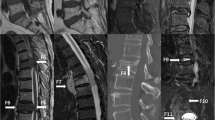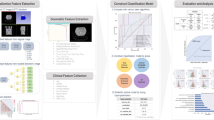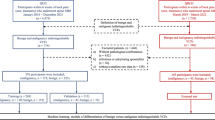Abstract
Objectives
To develop and validate a combined radiomics-clinical model to predict malignancy of vertebral compression fractures on CT.
Methods
One hundred sixty-five patients with vertebral compression fractures were allocated to training (n = 110 [62 acute benign and 48 malignant fractures]) and validation (n = 55 [30 acute benign and 25 malignant fractures]) cohorts. Radiomics features (n = 144) were extracted from non-contrast-enhanced CT images. Radiomics score was constructed by applying least absolute shrinkage and selection operator regression to reproducible features. A combined radiomics-clinical model was constructed by integrating significant clinical parameters with radiomics score using multivariate logistic regression analysis. Model performance was quantified in terms of discrimination and calibration. The model was internally validated on the independent data set.
Results
The combined radiomics-clinical model, composed of two significant clinical predictors (age and history of malignancy) and the radiomics score, showed good calibration (Hosmer-Lemeshow test, p > 0.05) and discrimination in both training (AUC, 0.970) and validation (AUC, 0.948) cohorts. Discrimination performance of the combined model was higher than that of either the radiomics score (AUC, 0.941 in training cohort and 0.852 in validation cohort) or the clinical predictor model (AUC, 0.924 in training cohort and 0.849 in validation cohort). The model stratified patients into groups with low and high risk of malignant fracture with an accuracy of 98.2% in the training cohort and 90.9% in the validation cohort.
Conclusions
The combined radiomics-clinical model integrating clinical parameters with radiomics score could predict malignancy in vertebral compression fractures on CT with high discriminatory ability.
Key Points
• A combined radiomics-clinical model was constructed to predict malignancy of vertebral compression fractures on CT by combining clinical parameters and radiomics features.
• The model showed good calibration and discrimination in both training and validation cohorts.
• The model showed high accuracy in the stratification of patients into groups with low and high risk of malignant vertebral compression fractures.


Similar content being viewed by others
Abbreviations
- CT:
-
Computed tomography
- LASSO:
-
Least absolute shrinkage and selection operator
- MRI:
-
Magnetic resonance imaging
- NPV:
-
Negative predictive value
- PPV:
-
Positive predictive value
- ROC:
-
Receiver operating characteristic
- ROI:
-
Region of interest
References
Mauch JT, Carr CM, Cloft H, Diehn FE (2018) Review of the imaging features of benign osteoporotic and malignant vertebral compression fractures. AJNR Am J Neuroradiol 39:1584–1592
Takigawa T, Tanaka M, Sugimoto Y, Tetsunaga T, Nishida K, Ozaki T (2017) Discrimination between malignant and benign vertebral fractures using magnetic resonance imaging. Asian Spine J 11:478–483
An HS, Andreshak TG, Nguyen C, Williams A, Daniels D (1995) Can we distinguish between benign versus malignant compression fractures of the spine by magnetic resonance imaging? Spine (Phila Pa 1976) 20:1776–1782
Yuzawa Y, Ebara S, Kamimura M et al (2005) Magnetic resonance and computed tomography-based scoring system for the differential diagnosis of vertebral fractures caused by osteoporosis and malignant tumors. J Orthop Sci 10:345–352
Sung JK, Jee WH, Jung JY et al (2014) Differentiation of acute osteoporotic and malignant compression fractures of the spine: use of additive qualitative and quantitative axial diffusion-weighted MR imaging to conventional MR imaging at 3.0 T. Radiology 271:488–498
Jung HS, Jee WH, McCauley TR, Ha KY, Choi KH (2003) Discrimination of metastatic from acute osteoporotic compression spinal fractures with MR imaging. Radiographics 23:179–187
Yuh WT, Zachar CK, Barloon TJ, Sato Y, Sickels WJ, Hawes DR (1989) Vertebral compression fractures: distinction between benign and malignant causes with MR imaging. Radiology 172:215–218
Li K, Huang L, Lang Z, Ni L, Du J, Yang H (2019) Reliability and validity of different MRI sequences in improving the accuracy of differential diagnosis of benign and malignant vertebral fractures: a meta-analysis. AJR Am J Roentgenol 213:427–436
Li Z, Guan M, Sun D, Xu Y, Li F, Xiong W (2018) A novel MRI- and CT-based scoring system to differentiate malignant from osteoporotic vertebral fractures in Chinese patients. BMC Musculoskelet Disord 19:406
Kaup M, Wichmann JL, Scholtz JE et al (2016) Dual-Energy CT-based display of bone marrow edema in osteoporotic vertebral compression fractures: impact on diagnostic accuracy of radiologists with varying levels of experience in correlation to MR imaging. Radiology 280:510–519
Gillies RJ, Kinahan PE, Hricak H (2016) Radiomics: images are more than pictures, they are data. Radiology 278:563–577
Lambin P, Leijenaar RTH, Deist TM et al (2017) Radiomics: the bridge between medical imaging and personalized medicine. Nat Rev Clin Oncol 14:749–762
Filograna L, Lenkowicz J, Cellini F et al (2019) Identification of the most significant magnetic resonance imaging (MRI) radiomic features in oncological patients with vertebral bone marrow metastatic disease: a feasibility study. Radiol Med 124:50–57
Burian E, Subburaj K, Mookiah MRK et al (2019) Texture analysis of vertebral bone marrow using chemical shift encoding-based water-fat MRI: a feasibility study. Osteoporos Int 30:1265–1274
Muehlematter UJ, Mannil M, Becker AS et al (2019) Vertebral body insufficiency fractures: detection of vertebrae at risk on standard CT images using texture analysis and machine learning. Eur Radiol 29:2207–2217
Lang N, Zhang Y, Zhang E et al (2019) Differentiation of spinal metastases originated from lung and other cancers using radiomics and deep learning based on DCE-MRI. Magn Reson Imaging 64:4–12
Hwang EJ, Jung JY, Lee SK, Lee SE, Jee WH (2019) Machine learning for diagnosis of hematologic diseases in magnetic resonance imaging of lumbar spines. Sci Rep 9:6046
Frighetto-Pereira L, Rangayyan RM, Metzner GA, de Azevedo-Marques PM, Nogueira-Barbosa MH (2016) Shape, texture and statistical features for classification of benign and malignant vertebral compression fractures in magnetic resonance images. Comput Biol Med 73:147–156
Lentle B, Trollip J, Lian K (2016) The radiology of osteoporotic vertebral fractures redux. J Clin Densitom 19:40–47
Guglielmi G, Muscarella S, Bazzocchi A (2011) Integrated imaging approach to osteoporosis: state-of-the-art review and update. Radiographics 31:1343–1364
McKiernan FE (2009) The broadening spectrum of osteoporotic vertebral fracture. Skeletal Radiol 38:303–308
Silverman SL (1992) The clinical consequences of vertebral compression fracture. Bone 13:S27–S31
Baur A, Stabler A, Arbogast S, Duerr HR, Bartl R, Reiser M (2002) Acute osteoporotic and neoplastic vertebral compression fractures: fluid sign at MR imaging. Radiology 225:730–735
Cuenod CA, Laredo JD, Chevret S et al (1996) Acute vertebral collapse due to osteoporosis or malignancy: appearance on unenhanced and gadolinium-enhanced MR images. Radiology 199:541–549
Zwanenburg A, Vallieres M, Abdalah MA et al (2020) The image biomarker standardization initiative: standardized quantitative radiomics for high-throughput image-based phenotyping. Radiology 295:328–338
Tibshirani R (1996) Regression shrinkage and selection via the LASSO. J R Stat Soc Ser B-Methodol 58:267–288
Sun XY, Feng QX, Xu X et al (2020) Radiologic-radiomic machine learning models for differentiation of benign and malignant solid renal masses: comparison with expert-level radiologists. AJR Am J Roentgenol 001:W44–W54
Onega T, Anderson M, Miglioretti D et al (2013) Establishing a gold standard for test sets: variation in interpretive agreement of expert mammographers. Acad Radiol 20:731–739
Forghani R, Chatterjee A, Reinhold C et al (2019) Head and neck squamous cell carcinoma: prediction of cervical lymph node metastasis by dual-energy CT texture analysis with machine learning. Eur Radiol 29:6172–6181
Carre A, Klausner G, Edjlali M et al (2020) Standardization of brain MR images across machines and protocols: bridging the gap for MRI-based radiomics. Sci Rep 10:12340
Ng F, Kozarski R, Ganeshan B, Goh V (2013) Assessment of tumor heterogeneity by CT texture analysis: can the largest cross-sectional area be used as an alternative to whole tumor analysis? Eur J Radiol 82:342–348
Ganeshan B, Abaleke S, Young RC, Chatwin CR, Miles KA (2010) Texture analysis of non-small cell lung cancer on unenhanced computed tomography: initial evidence for a relationship with tumour glucose metabolism and stage. Cancer Imaging 10:137–143
Skogen K, Ganeshan B, Good C, Critchley G, Miles K (2013) Measurements of heterogeneity in gliomas on computed tomography relationship to tumour grade. J Neurooncol 111:213–219
Ahn SY, Park CM, Park SJ et al (2015) Prognostic value of computed tomography texture features in non-small cell lung cancers treated with definitive concomitant chemoradiotherapy. Invest Radiol 50:719–725
Lubner MG, Stabo N, Lubner SJ et al (2015) CT textural analysis of hepatic metastatic colorectal cancer: pre-treatment tumor heterogeneity correlates with pathology and clinical outcomes. Abdom Imaging 40:2331–2337
Marshall R, Mandell J, Weaver M, Ferrone M, Sodickson A, Khurana B (2018) Imaging features and management of stress, atypical, and pathologic fractures. Radiographics 38:2173–2192
Boyle WJ, Simonet WS, Lacey DL (2003) Osteoclast differentiation and activation. Nature 423:337–342
Kim DH, Yoo HJ, Hong SH, Choi JY, Chae HD, Chung BM (2017) Differentiation of acute osteoporotic and malignant vertebral fractures by quantification of fat fraction with a Dixon MRI Squence. AJR Am J Roentgenol 209:1331–1339
Singh VA, Haseeb A, Alkubaisi AAHA (2014) Incidence and outcome of bone metastatic disease at University Malaya Medical Centre. Singapore Med J 55:539–546
Nakamoto Y, Osman M, Wahl RL (2003) Prevalence and patterns of bone metastases detected with positron emission tomography using F-18FDG. Clin Nucl Med 28:302–307
Burge R, Dawson-Hughes B, Solomon DH, Wong JB, King A, Tosteson A (2007) Incidence and economic burden of osteoporosis-related fractures in the United States, 2005-2025. J Bone Miner Res 22:465–475
Choi SH, Kim DY, Koo JW, Lee SG, Jeong SY, Kang CN (2020) Incidence and management trends of osteoporotic vertebral compression fractures in South Korea: a nationwide population-based study. Asian Spine J 14:220–228
Drake MT (2013) Osteoporosis and cancer. Curr Osteoporos Rep 11:163–170
Acknowledgements
The authors thank Sehee Kim, Department of Clinical Epidemiology and Biostatistics, University of Ulsan College of Medicine, Asan Medical Center, for her advice on statistical analysis.
Funding
This work was supported by the National Research Foundation of Korea (NRF) grant funded by the Korea government (MSIT) (NRF-2019R1G1A1097626).
Author information
Authors and Affiliations
Corresponding author
Ethics declarations
Guarantor
The scientific guarantor of this publication is Min A Yoon.
Conflict of interest
The authors of this manuscript declare no relationships with any companies whose products or services may be related to the subject matter of the article.
Statistics and biometry
Sehee Kim, Department of Clinical Epidemiology and Biostatistics, University of Ulsan College of Medicine, Asan Medical Center, kindly provided statistical advice for this manuscript.
Informed consent
Written informed consent was waived by the Institutional Review Board.
Approving body: Asan Medical Center Institutional Review Board.
Ethical approval
Institutional Review Board approval was obtained.
Methodology
• retrospective
• diagnostic or prognostic study
• performed at one institution
Additional information
Publisher’s note
Springer Nature remains neutral with regard to jurisdictional claims in published maps and institutional affiliations.
Supplementary information
ESM 1.
Supplementary Data S1. CT examination protocol. Supplementary Data S2. List of the 144 radiomics features extracted from each vertebra. Supplementary Data S3. List of the 26 radiomics features selected by the concordance correlation coefficient screening (DOCX 27 kb)
Rights and permissions
About this article
Cite this article
Chee, C.G., Yoon, M., Kim, K.W. et al. Combined radiomics-clinical model to predict malignancy of vertebral compression fractures on CT. Eur Radiol 31, 6825–6834 (2021). https://doi.org/10.1007/s00330-021-07832-x
Received:
Accepted:
Published:
Issue Date:
DOI: https://doi.org/10.1007/s00330-021-07832-x




